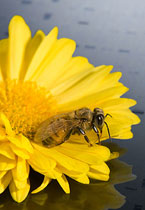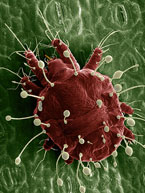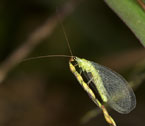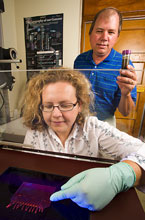Hot Research Topics 2007
Hot Topics Home
2015 | 2014 | 2013 | 2012 | 2011
2010 | 2009 | 2008 | 2007 | 2006
Agricultural Research Service Information Staff's Image Gallery - a complimentary source of high quality digital photographs
Food Safety and Security
 Machine's Eye View of Poultry and Produce - At the Instrumentation and Sensing Laboratory (ISL), a team of scientists-led by Yud-Ren Chen and including biophysicist Moon Kim, agricultural engineer Kuanglin Chao, and visiting scientists from around the globe-design the portable inspection devices.
Machine's Eye View of Poultry and Produce - At the Instrumentation and Sensing Laboratory (ISL), a team of scientists-led by Yud-Ren Chen and including biophysicist Moon Kim, agricultural engineer Kuanglin Chao, and visiting scientists from around the globe-design the portable inspection devices.
Chen, Chao, and visiting scientist Chun-Chieh Yang have finished work on a high-speed on-line imaging system for chicken inspection. They are turning over a prototype to industry as part of a cooperative research and development agreement with Stork-Gamco of Gainesville, Georgia, a major manufacturer of chicken-processing equipment. Chen and Kim and biomedical engineer Alan Lefcourt are working on a similar system for inspecting fruits and vegetables.
Agricultural Research magazine, January 2007 Complete Article
 Assessing the Risk, Retail Meat Analyzed - ARS scientists and colleagues have completed a study looking into sources of exposure to a microscopic parasite. The study provides the first risk assessment of the likelihood of exposure to Toxoplasma gondii-a common parasite worldwide-by ingestion of raw or undercooked meat.
Assessing the Risk, Retail Meat Analyzed - ARS scientists and colleagues have completed a study looking into sources of exposure to a microscopic parasite. The study provides the first risk assessment of the likelihood of exposure to Toxoplasma gondii-a common parasite worldwide-by ingestion of raw or undercooked meat.
After analyzing retail meat samples taken from nearly 700 stores across the country, the scientists found that the level of contamination from T. gondii is low but measurable in the cuts of whole pork evaluated.
Agricultural Research magazine, February 2007 Complete Article
 Advances in Protection Against Listeria - Fresh-cut fruits come with particular quality and shelf-life challenges. For example, food-contaminating microbes on a peel or rind's surface can piggyback onto a cutting knife and be dragged into the fruit's flesh.
Advances in Protection Against Listeria - Fresh-cut fruits come with particular quality and shelf-life challenges. For example, food-contaminating microbes on a peel or rind's surface can piggyback onto a cutting knife and be dragged into the fruit's flesh.
Now an ARS-led research team has found that applying a combination of antagonistic microorganisms and bacteriophages can be effective in reducing Listeria monocytogenes on fresh-cut honeydew melon pieces. L. monocytogenes is a foodborne human pathogen that tolerates environmental stress, multiplies at low temperatures, and survives refrigeration.
Agricultural Research magazine, March 2007 Complete Article
Nutrition
 Understanding Beta-Carotene Better - Carotenoids are fat-soluble pigments responsible for many of the colorful hues of plant leaves, fruits, and flowers. They also act as biological antioxidants, protecting cells and tissues from damage caused by naturally occurring oxygen free radicals in the body. And they've been linked to enhancing immune system function, protecting from sunburn, and inhibiting development of certain cancers.
Understanding Beta-Carotene Better - Carotenoids are fat-soluble pigments responsible for many of the colorful hues of plant leaves, fruits, and flowers. They also act as biological antioxidants, protecting cells and tissues from damage caused by naturally occurring oxygen free radicals in the body. And they've been linked to enhancing immune system function, protecting from sunburn, and inhibiting development of certain cancers.
Agricultural Research magazine, January 2007 Complete Article
 Better Living Through In-Depth Food Analysis - More than 90 percent of folks in the United States get inadequate amounts of vitamin E from their diets, according to the Agricultural Research Service. We know this because surveyors query people about what they've eaten, and then other research nutritionists translate "foods eaten" into "nutrients consumed."
Better Living Through In-Depth Food Analysis - More than 90 percent of folks in the United States get inadequate amounts of vitamin E from their diets, according to the Agricultural Research Service. We know this because surveyors query people about what they've eaten, and then other research nutritionists translate "foods eaten" into "nutrients consumed."
But how do nutritionists calculate the individual vitamins and minerals people get based on a list of foods and drinks they reported having eaten?
Agricultural Research magazine, August 2007 Complete Article
Sustainable Farming
 No Shortcuts in Checking Soil Health - A relatively new long-term experiment at Beltsville, Maryland, has shown that organic farming can build soil organic matter better than conventional no-till farming can.
No Shortcuts in Checking Soil Health - A relatively new long-term experiment at Beltsville, Maryland, has shown that organic farming can build soil organic matter better than conventional no-till farming can.
From 1994 to 2002, ARS scientists compared minimal-tillage organic corn, soybean, and wheat with the same crops grown conventionally with no-till.
Agricultural Research magazine, July 2007 Complete Article
 Socking It to Strawberry Root Rot - Who'd have thought that compost-filled filter socks could substitute for the banned soil fumigant methyl bromide? But tests have shown that planting strawberries in these flexible tubes significantly reduced incidence of black root rot and increased yields 16- to 32-fold.
Socking It to Strawberry Root Rot - Who'd have thought that compost-filled filter socks could substitute for the banned soil fumigant methyl bromide? But tests have shown that planting strawberries in these flexible tubes significantly reduced incidence of black root rot and increased yields 16- to 32-fold.
The socks can be made of cotton, burlap, or other textile fibers or of plastic, including the biodegradable kind. Their uses include replacing fabric silt fences that hold back eroding soil at construction sites, road and streambank stabilization, flood control, and horticultural production.
Agricultural Research magazine, September 2007 Complete Article
 Tough Trees Finding smart plantings for urban spaces - Life on the street...it can be a rough existence. Even for trees. Leafy city dwellers face a variety of assaults-from daily foot traffic pounding their roots, to extreme weather events such as limb-busting ice storms and debilitating drought, to the soot and salt that all urbanites must tolerate.
Tough Trees Finding smart plantings for urban spaces - Life on the street...it can be a rough existence. Even for trees. Leafy city dwellers face a variety of assaults-from daily foot traffic pounding their roots, to extreme weather events such as limb-busting ice storms and debilitating drought, to the soot and salt that all urbanites must tolerate.
That's why ARS scientists at the U.S. National Arboretum (USNA) have spent 4 years studying various trees for urban-worthiness.
Agricultural Research magazine, October 2007 Complete Article
Genomics
 Genetic Evaluations Help Breed Better Bossies - Scientists recently added calf survival as a genetic evaluation trait to a series of calculations that leads to what's called "Lifetime Net Merit." This genetic index for a bull predicts the profitability of his daughters.
Genetic Evaluations Help Breed Better Bossies - Scientists recently added calf survival as a genetic evaluation trait to a series of calculations that leads to what's called "Lifetime Net Merit." This genetic index for a bull predicts the profitability of his daughters.
Such evaluating of dairy cattle genetic traits has allowed dairy farmers to increase milk production to all-time highs. Some of the traits evaluated are milk produced, its fat and protein content, pregnancy rate, calving ease, and now stillbirth rate.
Agricultural Research magazine, January 2007 Complete Article
 Honey Bee Genetics Vital in Disease Resistance - As pollinators and food providers, honey bees are a key beneficial insect. They pollinate about 130 fruit, vegetable, nut, ornamental, and fiber crops in the United States. In all, their efforts contribute about $15 billion annually through improved crop yield and product quality in the form of larger or more appealing fruits. Sale of hive products-honey, wax, pollen, royal jelly, and even venom-generates hundreds of millions more.
Honey Bee Genetics Vital in Disease Resistance - As pollinators and food providers, honey bees are a key beneficial insect. They pollinate about 130 fruit, vegetable, nut, ornamental, and fiber crops in the United States. In all, their efforts contribute about $15 billion annually through improved crop yield and product quality in the form of larger or more appealing fruits. Sale of hive products-honey, wax, pollen, royal jelly, and even venom-generates hundreds of millions more.
Thanks in large part to their agricultural importance and potential to inform human medicine, honey bees recently joined an elite group. They're among the first insects whose entire genomes have been unveiled before scientists. The Honey Bee Genome Project became a reality in late 2002, with funding provided by the U.S. Department of Agriculture and the National Institutes of Health, an organization interested in using bees as a model for understanding human health. The effort has already provided a significant new source of genes for study. The functions of these genes can be assessed through various high-tech methods. Genes can then be connected to disease resistance or other desirable traits, providing new tools for breeding and scoring honey bee lines that can cope with the challenges faced by bees today.
Agricultural Research magazine, January 2007 Complete Article
 Uncorking Genetic Bottlenecks in Soy - Soybeans are second only to corn as America's most widely grown crop, with nearly 76 million acres planted in 2006. That's because the nitrogen-fixing legume, which originated in Asia, is incredibly versatile.
Uncorking Genetic Bottlenecks in Soy - Soybeans are second only to corn as America's most widely grown crop, with nearly 76 million acres planted in 2006. That's because the nitrogen-fixing legume, which originated in Asia, is incredibly versatile.
And yet, for all its versatility, soy sits atop a narrow genetic base that, some researchers contend, could leave it vulnerable to exotic new diseases or insect pests.
Researchers at the ARS Soybean Genomics and Improvement Laboratory (SGIL) in Beltsville, Maryland, are looking for efficient ways to uncork this so-called genetic bottleneck in today's soybean crop, and they're using valuable genetic resources preserved at another ARS facility, in Urbana, Illinois.
Agricultural Research magazine, November 2007 Complete Article
Insect Pests
 A Tiny Menace Island-Hops the Caribbean - USDA scientists have joined a multinational effort to stop a tiny mite that may create big problems in and near this hemisphere's Tropics.
A Tiny Menace Island-Hops the Caribbean - USDA scientists have joined a multinational effort to stop a tiny mite that may create big problems in and near this hemisphere's Tropics.
Researchers at the Department's Agricultural Research Service (ARS) and at the Animal and Plant Health Inspection Service (APHIS)-are targeting the red palm mite, Raoiella indica. This pest rides the wind and was known for attacking coconut palms in the Eastern Hemisphere's tropical and subtropical regions.
Agricultural Research magazine, May 2007 Complete Article
 A Natural Insect Attractant From Catnip - Discoveries in science can occur where and when least expected. For chemist Kamal Chauhan and entomologist Jeffrey Aldrich, an important finding came when they were testing a new compound for its potential as an insect repellent.
A Natural Insect Attractant From Catnip - Discoveries in science can occur where and when least expected. For chemist Kamal Chauhan and entomologist Jeffrey Aldrich, an important finding came when they were testing a new compound for its potential as an insect repellent.
The researchers are with the ARS Chemicals Affecting Insect Behavior Laboratory, Beltsville, Maryland. They conducted a field study to test the repellent properties of a chemical compound they had separated from catnip oil. But they found that, instead of repelling insects, the compound attracted lacewings, which prey on several crop and garden pests.
Organic farmers and growers purchase lacewings as eggs or larvae to protect crops from aphids and mites. "They are an important, commercially available predator of these insects," says Aldrich.
Agricultural Research magazine, May 2007 Complete Article
Weed Control
 Seeds of Knowledge, New online guide helps identify the world's seeds and fruits - Federal inspectors are at the front lines of the battle against these invasives. Stationed at ports around the country, they stand ready to screen incoming plant materials for possible unwanted stowaways. But trying to identify hundreds of unusual seeds and fruits-from as far away as Asia, Australia, or Central and South America-is a daunting task.
Seeds of Knowledge, New online guide helps identify the world's seeds and fruits - Federal inspectors are at the front lines of the battle against these invasives. Stationed at ports around the country, they stand ready to screen incoming plant materials for possible unwanted stowaways. But trying to identify hundreds of unusual seeds and fruits-from as far away as Asia, Australia, or Central and South America-is a daunting task.
That's why seed experts-systematists with the Agricultural Research Service (ARS) in Beltsville, Maryland-play such an important support role in helping to prevent entry of damaging weeds into the country. These researchers may be called on by other agencies, such as the USDA's Animal and Plant Health Inspection Service, to help identify strange and suspicious seeds, fruits, and fungi.
Agricultural Research magazine, February 2007 Complete Article
Animal Health
 Curbing Coccidiosis in Chickens, A Fine-tuned Approach - Each year, U.S. poultry producers raise about 7 billion broilers. They use a combination of antibiotics and vaccines to protect these birds from infectious diseases. Antibiotics are critical to ongoing efforts to fight off diseases and infections; they have been able to kill or stop growth of many different kinds of protozoa and parasites as well as bacteria.
Curbing Coccidiosis in Chickens, A Fine-tuned Approach - Each year, U.S. poultry producers raise about 7 billion broilers. They use a combination of antibiotics and vaccines to protect these birds from infectious diseases. Antibiotics are critical to ongoing efforts to fight off diseases and infections; they have been able to kill or stop growth of many different kinds of protozoa and parasites as well as bacteria.
One major disease of chickens-coccidiosis-is named after intestinal parasites collectively referred to as coccidia, which are tiny, single-celled protozoans within the genus Eimeria. Coccidiosis makes it more difficult for the bird to absorb feed and gain weight and costs U.S. producers well over $600 million annually in economic losses.
Agricultural Research magazine, February 2007 Complete Article
 Plant-Produced Protein Eases Dairy Cow Infection - ARS researchers have developed a new approach to thwart bacteria that cause coliform mastitis, an inflammatory udder disease of dairy cows.
Plant-Produced Protein Eases Dairy Cow Infection - ARS researchers have developed a new approach to thwart bacteria that cause coliform mastitis, an inflammatory udder disease of dairy cows.
Coliform mastitis is the most prevalent form of clinical mastitis in the dairy industry and is mainly caused by the Escherichia coli bacterium. Use of antibiotics to control mastitis infections can be expensive and carries with it concerns about the emergence of antibiotic-resistant bacteria. Yet mastitis is expensive too, costing dairy farmers an estimated $2 billion annually from incapacitated cows and milk that can't be sold.
Agricultural Research magazine, September 2007 Complete Article
